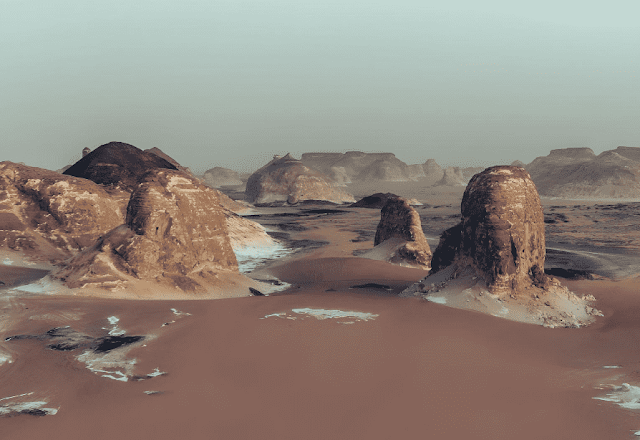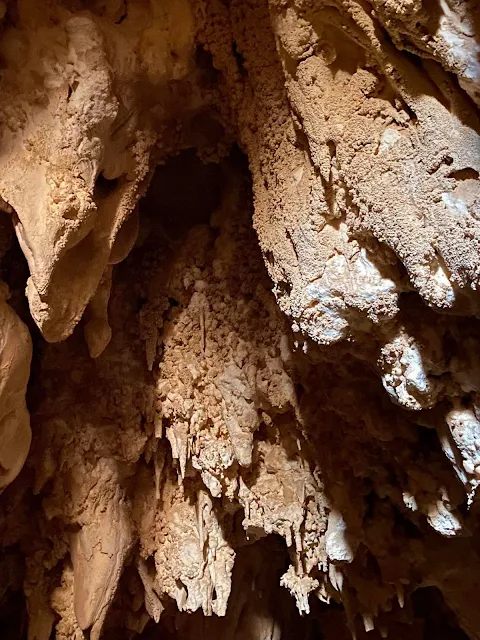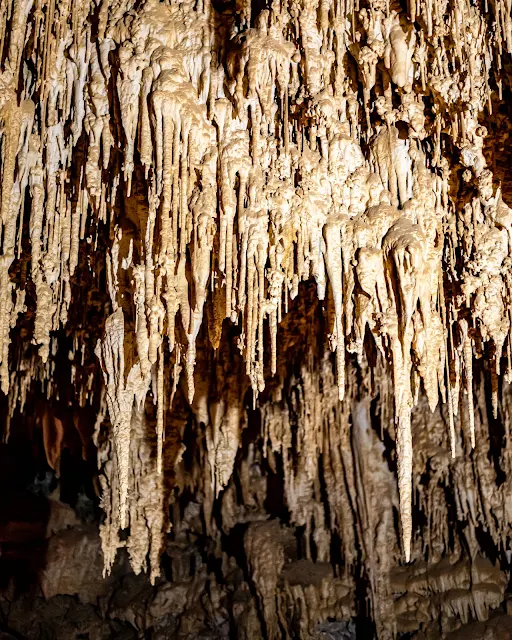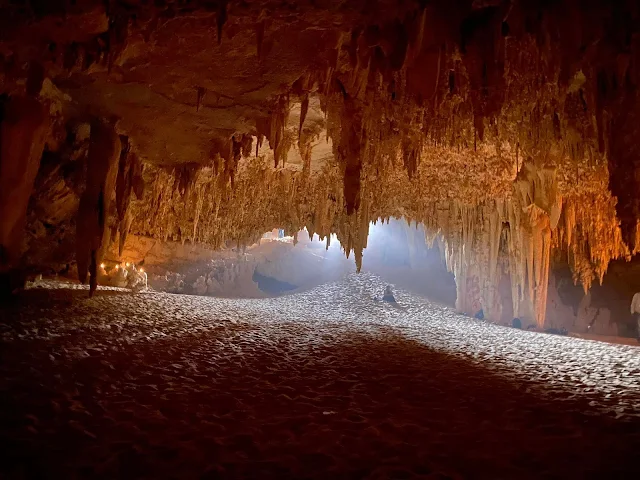The oasis of Farafra Travel Guide
The oasis of Farafra, Known as Ta-Telecinco or the land of the cow in Pharaonic times, is a remote village, the oldest part of which sits on a hill next to peaceful palm groves, at a short distance, the waters are sulphurous springs at Bir Setta and El-Mufid lake where you can swim. Oasis of Farafra houses Qasr Al-Qasr and Abu Minqar which are the remains of Roman constructions. An art center that houses a museum and a workshop exhibiting paintings and ceramics by local artists sits in a garden full of sculptures made from materials available in the desert. Beautiful hand-knitted camel hair sweaters, socks and scarves are also locally produced. Day trips by jeep and camel treks here to the White Desert, Bahariya, Dakhla and Siwa can be arranged.
Crystal Mountain in Farafra Oasis Egypt
Egypt has a lot of amazing Desert Safari Tours and best sites to explore, enjoy Egypt Safari desert tours to visit Bahariya oasis, White Desert, Black Desert, Farafra Oasis, Dakhla Oasis, Kharga Oasis, feel the real nature and beauty, sleep under the stars, touch the desert life, meet with Egyptian friendly people, and more. Explore new era of Safari Trips in Egypt.
Crystal Mountain is located between the Bahariya and Farafra areas. It is about 90 km from Farafra, about 160 km from Bahariya, and 10 km from Agabat. The crystals are not Quartz crystals, they are probably Barite (Schwerspat, BaSO4) and/or Calcite crystals (Kalkspat, CaCO3), It's easy to ascertain the hardness of the crystals. Quartz (SiO2) has a Mohs Scale hardness of 7, Barite and Calcite have a Mohs scale hardness of 3.5 - 3.0. Quartz crystal can scratch glass, Barite or Calcite can it not.
The origin of this Crystal Mountain is interesting. The hill was opened during construction of the road from Farafra to Bahariya by chance and destroyed in part. The material was installed into the road. Today is the Crystal Mountain a popular stop for the tourists.
Still more interesting is the geological context. The hill is not a paleokarst cave with columnar-shaped stalagmites. It is a subvolcanic vault, which emerged probably during the Oligocene age. The visible layers are e.g. White Desert limestone of the Khoman Fm.* (Late Cretaceous age), as well as a younger coal seam and hydrothermal impregnated reddish to brownish ferruginous layers.
The strata are broken or brecciated and intensely folded with each other. It can be ascertained that intense heat caused the coal seam to be transformed to anthracite (?). The crystals have grown out of hot hydrovolcanic solutions. The hot solutions were highly concentrated with BaSO4 and/or CaCO3, which had been dissolved from the sediments. The solutions have penetrated into all cavities. After the cooling of the solutions the crystals could grow. It formed columns or round domes with crystals within.

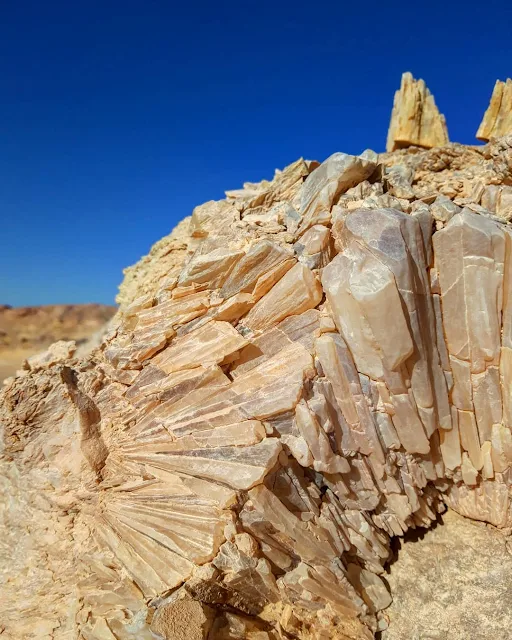
Crystal Mountain in Egypt... one of the most expensive mountains in the world This mountain is considered one of the richest mountains because it contains very rare and colorful crystal pieces drawn by nature The Crystal Mountain is located in the Farafra oases in the New Valley Governorate, and it is located within the White Desert tourist area in the center of Farafra. The Crystal Mountain is a rock consisting of pieces of crystal, as it is considered one of the most important tourist attractions in the New Valley in particular and in Egypt in general. This mountain is characterized by its most beautiful scenery. The charming, as these scenes simulate a charming, picturesque nature, and these rocks were formed by geological factors over time.
White Desert National Park
Sahara el Beyda, the White Desert Protected Area, is a national park in Egypt, first established as a protected area in 2002. It is located in the Farafra depression, 45 km (28 mi) north of the town of Qsar El Farafra. Part of the park is in the Farafra Oasis (New Valley Governorate).
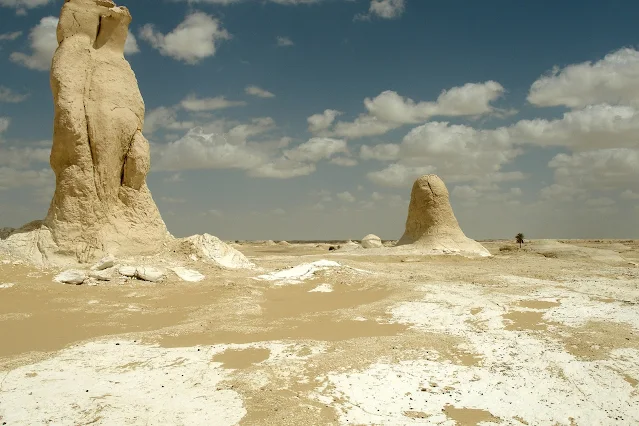
The park is the site of large white chalk rock formations, created through erosion by wind and sand. It is also the site of cliffs (at the northern end of the Farafra Depression), sand dunes (part of the Great Sand Sea), as well as Wadi Hennis and oases at Ain El Maqfi and Ain El Wadi.
White Desert National Park covers an area of 3,010 km2 (1,160 sq mi). The highest point in the park is at El Qess Abu Said at 353 m (1,158 ft) above sea level, and the lowest is at Wadi Hennis at 32 m (105 ft).
The park serves as the refuge for various animals, including the endangered Rhim gazelle and the vulnerable Dorcas gazelle, as well as Barbary sheep; jackals; Rüppell's, red and fennec foxes; and the sand cat.
Valley of Aqabat
n the heart of the White Desert in the Farfra Oasis in Egypt lies the "Valley of Agabat or the Obstacles", which geologists believe is very similar to the surface of mars. The Aqabat Valley is a place of magical beauty that is not repeated anywhere else in the Egyptian desert. It is located en route between the oases of Bahariya and Farafra, near Crystal Mountain and the White Desert.
Millions of years ago, the place used to be under the sea. Over the years, unique rock formations of limestone, chalk (and maybe sand) developed. When you stand atop the small rock cliff at one of the valleys and the valley with the rock formation unfolds before you, and there is not a single trace of another living being in the whole vicinity - you'll find a unique moment of peace.
The main characteristic of the valley of Aqabat is the contrast between the large rocks of impressive white color and the golden sand that surrounds them. The landscape is so beautiful and one can hardly imagine another place like this in the whole world.
Black Desert Egypt
The Black Desert (Arabic: الصحراء السوداء, aṣ-Ṣaḥrāʾ as-sawdāʾ) is a region of volcano-shaped and widely spaced mounds, distributed along about 30 km (19 mi) in western Egypt between the White Desert in the south and the Bahariya Oasis in the north. Most of its mounds are capped by basalt sills, giving them the characteristic black color.
The mounds of the Black Desert, up to 100 metres (328 feet) high, vary in size, composition, height, and shape as some are dark consisting of iron quartzite while others are more reddish as its surface rocks consist of iron sandstone. On the outskirts of the Black Desert are volcanic hills proving the eruption of dark volcanic dolerite, dating back to the Jurassic period 180 million years ago.
Remains of shrubs, and fossilized woodlands have been found in the Black Desert indicating that plants once grew there.
Gara Cave | Djara Cave Egypt
Gara cave was rediscovered twice, initially discovered by the German explorer Gerhard Rohlfs, and then forgotten for millennia, recently rediscovered in 1989 by the German adventurer Dr Carlo Bergmann, who was exploring the area by camel.
A german traveller who followed abandoned Bedouine tracks alone by camel. He published his discovery in a popular German science magazine, and also mentioned the cave paintings for the first time. He also left an engraving with his name and the date in the cave wall, a habit which is today considered graffiti. In 1990 the first official archaeological surveys and test excavation occurred, but Hugh J.L. Beadnells stone tools had disappeared. During the 1990 numerous scientific explorations were made as part of the ACACIA expedition by an interdisciplinary team from Cologne, Berlin and Cairo.
Around 2000 scientific exploration was completed, and since then it was possible to visit the cave again. Even a sign was placed, written on a stone, and a trail marked with two rows of rocks, otherwise the cave is undeveloped. The visit is a two-day desert trip from Bahariya, which must be organized in advance. The trip must be registered at the police station, which is normally done by your operator. Until today officials kept limiting access due to its proximity to trouble spots in the Western Desert. The cave originally had a cave book where visitors left comments, but unfortunately it was stolen around 2010. In 2018 a road was planned from Farafra to Assuit, passing right by the cave.
Djara or (Gara) is a cave of magical dimensions, as it is one of the very few well decorated caves in Egypt; it has the natural result of pure water in contact with the dry desert climate, over millions of years of formation, the cave itself is about 30m wide and 8m high, and contains animal engravings dating back from the Neolithic Period. It is close to the crossroads of the Darb Assiut, the caravan trail connecting Farafra Oasis and Assiut, and the Abu Muharraq sand dune, at approximately 1.500kms the longest dune in the Western Desert. It is 180kms from both Bahariya and Farafra.
The Gara cave remains as one of the most stunning examples of the effect of chemical activity over millennia, and a unique treasure of nature's own version of cave art. Today it is classified Institute as the second most important Stone-Age settlement in the Western Desert after Nabta Playa by the German Archaeological Institute.
A cave of magical dimensions, the Djara cave is the natural result of pure water in contact with the dry desert climate , where an immense amounts of water that have accumulated over an extended period of time, over millions of years of formation. The cave is unlike any other in the region, and presents its viewers with a fairy-tale like atmosphere of staggering depth and proportions.
To the common visitor and resident of Egypt, the Djara cave is almost unheard of. The cave contains a ceiling of what appears to be fluted limestone formations that mimic the effect of frozen dripping water, almost like asymmetrical folds of drapery in stone and crystal that were made during the Holocene wet phase, when this area was occupied by early hunters/gatherers. Remains on the surface were dated by C-14 to be 8600-6000 BP.
The Djara region, an area with a size of almost 5 by 10km, was inhabited during this time. It was wetter, so life was possible, but there was not enough rain for the growth of flowstone.Rohlf’s Say.. Rohlf's discovery was on Christmas eve in 1973, he describes his experience and the revelation of the prehistoric cave as follows: "A chalk stone cave opened out of the ground, whose beauty and size surpassed our dreams: stalactites three to four feet long hung from the roof in elegant draperies, purer and more transparent than any we had seen elsewhere...these stalactites were indeed mysterious, formed by dripping fresh water in a desert that is now completely devoid of water." Who would have thought that such a phenomenal discovery of an ancient cave would've been made in the midst of the arid planes of the desert, for which Rohlf himself was in shock, and for which he received three awards.
The cave is easy to visit; many parts have a level floor, covered by the sand of the desert. Light is required and a helmet is a good idea too. Safari programs and excursions to explore the beauty of the Egyptian white desert are arranged and organized by many travel agencies, who work on feeding the curiosity of adventure lovers and launch trips to the most exotic destinations along days and days of excitement. Ain al-Sarw in the Farafra desert
Real magic in Farafra Oasis, when you ask for water, it rises specially for you from the ground The magic of this eye is not only in its beauty, but it is a real magic, as it is a spring of underground farm water found in the White Desert Reserve in the New Valley, north of the Farafra Oasis in Egypt.
It is a wonderful eye. It is enough for you to be in the desert, and thirst, stress and sweat intensified. Once you approach it, the earth begins to fill the eye with fresh water, and the water inside the eye rises slowly slowly without any warning or any sign until it is completely filled and floats on the ground, so you drink and bathe and take whatever you want. I left it and left, it went back down slowly slowly until it was completely dry on Monday three and maybe a month or two months or more until another person or even an animal needed it, so it does not trust anyone as if it is alive with its fresh water.This phenomenon is a fact and it is not just a joke and many have seen it, especially the people of the region who talk about it, but in order not to be confused, it has a scientific analysis that clarifies this strange phenomenon, which is that the land in this region has a special type of soil that resembles a piece of sponge. This sponge serves as a store of water in the ground. He approaches it, that is, as if he is alive and presses on the ground in the circle of this magical eye, which leads to what is in it of water and comes out what is stored inside it, so it is in fact not magic even if it seems so.
The strange thing about it is that any underground water source in the world pumps water day and night until it dries up completely and stops leaving the water out of it and dries up within the range of 50 to 70 years. As for in the cypress spring, this is exactly the opposite. It does not come out of its water unless any living person approaches it. Even if it is a small bird that you take out the water with complete satisfaction until it leaves and returns to drought.
Everything in the Ain al-Sarw area is beautiful, when you go to Farafra, you will see the splendor and beauty of the yellow desert turning to the green of the oasis, and you will meet all the time forms of limestone need a whole day to enjoy their beauty and when you approach a group of palm trees appear on the horizon in the form of a circle Surprised that it is the eye of cypress, but the most wonderful is what you hear from interesting conversations about that enchanted, charming eye, and the most wonderful when you see it is eye visions.














